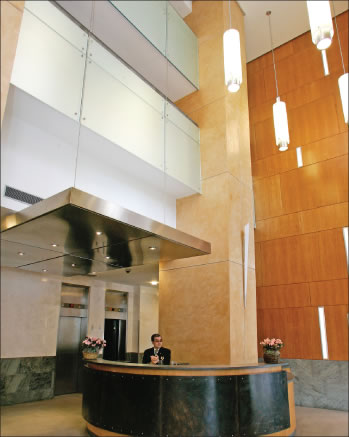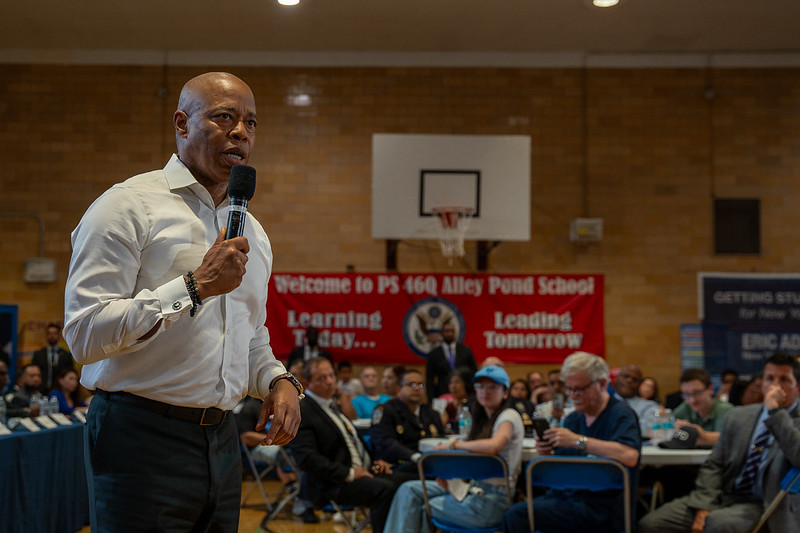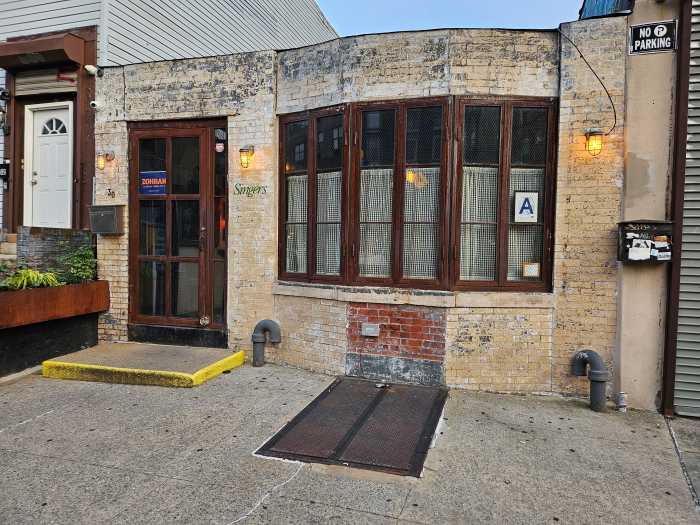By Julie Shapiro
A group of Lower Manhattan residents recently set out to determine how much affordable housing their neighborhood has.
The answer? Not much.
“Upon doing research, I don’t think there is affordable housing Downtown,” said Tom Goodkind, a Battery Park City resident who launched the fact-gathering effort.
Goodkind, working with other Community Board 1 members and the board office, found 4,600 rent-regulated units in 16 buildings below Canal St.
Rent-regulated does not necessarily mean affordable. The community board’s list includes many units that are considered regulated because the yearly rent increases are capped, but the units start out at market rate.
“It was not as many buildings or units as I had hoped,” said Michael Levine, director of land use and planning for C.B. 1. “We’ve lost a lot.”
The big picture, Goodkind and Levine agreed, is not bright. The neighborhood is losing affordable units faster than they could ever be built, and despite the current softening of the market, many housing advocates say that prices Downtown are still much higher than the middle class can afford.
Tribeca has the most expensive non-doorman rentals in Manhattan, according to a Real Estate Group of New York April market report. One-bedrooms in non-doorman Tribeca buildings average $4,300 a month, the report found.
“So much of what makes C.B. 1 C.B. 1 is its current diversity,” Levine said. “We don’t want it to only be one class of people. We want it to be older and younger people as well as office workers. We’re afraid of losing that diversity.”
From residents to housing activists, everyone agrees that the fear is legitimate. Lower Manhattan has undergone a slew of changes in the past 10 years and boasts a rapidly growing residential population. Perennially one of the city’s wealthiest neighborhoods, Lower Manhattan has also welcomed middle-class residents in large complexes like Gateway Plaza, Independence Plaza North and Southbridge Towers.
But changes have come or could be on the way at all three of those complexes, causing some to question how much longer the neighborhood will be an option even for upper-middle-class families.
Gateway Plaza
The most recent affordable housing victory Downtown came earlier this month, when Assembly Speaker Sheldon Silver announced an agreement for an 11-year extension of rent protections at Gateway Plaza, a 3,500-tenant complex in Battery Park City.
But the win was bittersweet, because unlike the two previous extensions Silver secured, this one came with a caveat: All new tenants, who enter at market rents, would have no guarantee that they could renew their lease at a stabilized rate under the deal, which has not yet been finalized.
Several Gateway tenants who spoke to Downtown Express were relieved that they would stay protected but upset that new tenants won’t have the same security.
“It looks like a victory but it isn’t,” said Barry Skolnick, a Gateway resident and C.B. 1 member. “It sounds the death knell for stabilized housing in Lower Manhattan…. I’m very disappointed.”
Skolnick said the real winner in the Gateway deal is The LeFrak Organization, which owns the complex, since they will get to rent vacant apartments at market rate and won’t have to pay to keep existing tenants stabilized. Under the Silver agreement, the Battery Park City Authority will reimburse LeFrak for the rent protections offered. Silver did not have as much leverage in negotiating this deal as he did in the past, and even those who criticized the deal said Silver did the best he could.
Silver released a statement saying he is “very pleased” with the agreement for the 1,705-unit complex.
Skolnick sees the fall of Gateway Plaza as one of a string of affordable housing setbacks in Lower Manhattan that will make the neighborhood uninhabitable for all but the wealthiest residents. Higher housing prices mean more expensive groceries and cultural events, which makes the neighborhood unwelcoming to the middle class, Skolnick said.
“We’re sacrificing the future for the present,” he said.
Linda Belfer, head of the Gateway tenant association, is worried that the lack of protections for new tenants will create two classes of tenants.
“That’s the disappointing part for me,” she said. “But you can look at the glass half full or half empty…. It’s better than no agreement.”
I.P.N. and Southbridge
For a look at Gateway Plaza’s future, residents can turn to Tribeca’s Independence Plaza North, another large middle-class complex that is slowly going market-rate.
Independence Plaza owner Laurence Gluck removed the complex’s 1,339 units from the Mitchell-Lama affordable housing program in 2004, and from then on, all new tenants came in at market rate. Most of the tenants who lived at I.P.N. before 2004 were able to stay under either a federal voucher or another assistance program, but about a quarter have since moved out, estimated Diane Lapson, leader of the I.P.N. tenant association.
Lapson sees a change in the character of the building since then.
Many of the new residents are young professionals living with several roommates who see the building more as a stop along the way than a place to set down roots, Lapson said. Unless they are looking to raise children in the neighborhood, they rarely join the tenant association. Lapson often walks into an elevator now and doesn’t know anyone inside, something that would have been unthinkable 10 years ago.
“It’s a weird thing,” Lapson said. “A lot of the new people aren’t quite as friendly. Half of them don’t speak to anybody, and some are gone in a year.”
Gluck, the complex owner, said the new market-rate tenants helped pay for recent capital improvements, including the renovation of the building lobbies. Both the market-rate tenants and the protected tenants get to enjoy these improvements, he said in a phone interview.
Belfer said the I.P.N. and Gateway cases are hard to compare, because new Gateway tenants have been coming in at market rate all along, while I.P.N. tenants had greater protections before exiting Mitchell-Lama. Also, Gateway has never had income restrictions or rents based on income, Belfer said.
In addition to Gateway and Independence Plaza, the other affordable Lower Manhattan mega-complex is Southbridge Towers in the Seaport. Southbridge is a 1,651-unit Mitchell-Lama co-op with income restrictions for new residents, who are selected by lottery. The board of directors hopes to privatize the building, allowing residents to sell their apartments at market rate, essentially removing those units from protections.
Unlike the situation at Gateway and I.P.N., the fate of Southbridge is in the residents’ hands, since they own the complex. If Southbridge leaves Mitchell-Lama, residents would be able take ownership of their individual apartments.
Southbridge is close to filing a detailed report on privatization, called a “red herring,” and the proposal would then go to the attorney general and finally back to the residents. Two-thirds of the apartments would have to approve the privatization plan.
Wally Dimson, president of the Southbridge board, said going private would not change the character of Southbridge Towers. Unlike at I.P.N. and Gateway, Southbridge is a co-op so it will continue to attract people looking to invest in the neighborhood rather than high-paying renters, Dimson said. He expects the market-rate mortgages to still be affordable to middle-class people like city workers if the residents approve privatization.
“I think it would invigorate the neighborhood,” Dimson said of privatization. “It would be affordable in a different way.”
Paul Hovitz, a Southbridge resident who opposes privatization, does not think the residents will vote in favor of it. Hovitz said it’s unfair for current residents to seek the financial benefits of privatization while knocking out one of the last affordable complexes in Lower Manhattan.
“If it weren’t for the Mitchell-Lama program, I never could have afforded to live in Manhattan,” Hovitz said. “Other people who want to live in the city should have the same chance that I had.”
The new middle class
Many Lower Manhattan residents, including Hovitz, said the neighborhood has too few apartments that the middle class can afford, partly because city, state and federal programs often target those making less than $40,000, not teachers and police officers making $70,000 a year and more. That results in residents at one end of the spectrum or the other, who either qualify for subsidies or don’t need them, without much room in between, Hovitz said.
“We’re not a country club community, but we could end up becoming that,” Hovitz said.
As housing prices rise, the definition of the middle class and what that class can afford is changing, several housing advocates said.
“The middle class is not making $40,000 or $50,000,” said Susan Cole, associate director of the Settlement Housing Fund, which develops affordable rentals. “[Even] $90,000 is not a lot of money in New York for a family of three or four.”
But the middle class has few options as New York loses protected apartments every year when landlords exit government programs.
“There’s something very remiss,” Cole said. “How do you get back to something that’s realistically affordable?”
While the middle class is the focus of many Downtown residents and C.B. 1 members, several housing advocates said the government should focus on lower-income residents first.
“We are having to do triage to some extent,” said Dina Levy, director of organizing and policy at the Urban Homesteading Assistance Board. “We have to stop the bleeding, then regroup.”
Census numbers
The community board’s survey of affordable housing was done informally, by looking at state lists and calling building managers to find out about rent protections. The board only included buildings with 40 or more units.
More official numbers come from the U.S. Census Bureau’s 2008 Housing and Vacancy Survey, though the results lump Community Board 1 with Community Board 2.
In that broader area, which goes up to 14th St. on the West Side and the Brooklyn Bridge on the East Side, the survey found 51,000 rentals and 21,000 condos and co-ops, said Tom Waters, a housing analyst who crunched the census numbers.
About half of the rental units were rent-regulated, and about a quarter, or just under 13,000 units, rented for less than $1,400 a month, said Waters, who works for Community Service Society of New York.
Neither the census survey nor the community board survey includes buildings like Independence Plaza or Gateway Plaza, which are regulated under agreements negotiated with the landlords, not government-administered programs.
Levine, from C.B. 1, said the census data might overstate the number of affordable units, since the state often lists buildings that were once protected but no longer are.
The census survey also showed that many apartments are going market-rate when tenants move, Waters said. Among tenants who have lived in the same place since before 2005, about half were paying less than $1,400 a month, Waters said. Among those who had moved into a new apartment since 2005, less than 10 percent had such a low rent.
“Everywhere in Manhattan below Harlem, apartments are being deregulated on vacancy,” Waters said. “That’s a pretty significant loss of affordable housing.”
Lower Manhattan also had fewer affordable complexes than other neighborhoods to begin with, because urban renewal projects Downtown usually focused on government buildings, not housing, Waters said.
Solutions
To solve the top problem facing affordability advocates — money — City Councilmember Alan Gerson has proposed affordable housing funds. The idea is to have the government and developers seeking city approvals pay into the funds and then to have the city use that money to preserve affordable units locally.
“The No. 1 challenge in our district is preservation,” Gerson said. “Even under the best circumstances, we’ll always lose more [affordable housing] than we create. We’ll always be playing catch-up.”
Gerson and several housing advocates pointed out that preserving existing affordable housing is more efficient than building new units.
The Lower Manhattan Development Corp. has put $50 million toward affordable housing, of which $16 million went into a fund for Chinatown and the Lower East Side. That fund has $2.8 million left after $6 million went to Masaryk Towers, $5 million went to Knickerbocker Village and $100,000 subsidies went to renovate units at 81 Baxter St., 28-30 Henry St., 58-60 Hester St., 191 Madison St. and 112-114 Eldridge St., the city said.
Gerson also wanted the city to start a general Lower Manhattan housing fund, using $5 million from Time Equities. The developer agreed to the $5 million contribution in exchange for the city approving a 63-story market-rate condo and hotel tower at 50 West St. Time Equities was supposed to pay half of the $5 million upon buying air rights for the project from the city and the other half when the building opened.
Time Equities agreed in 2007 to pay into the affordable housing fund, but the initial $2.5 million has not yet made its way to the city Dept. of Housing Preservation and Development. H.P.D. spokesperson Seth Donlin said the city Office of Budget and Management has the $2.5 million and will turn it over to H.P.D., but he did not know when that would happen.
Gerson’s office said the $2.5 million was supposed to go to some housing projects in Chinatown, but since it did not come through in time, the city used money from the Battery Park City Authority’s surplus instead. Donlin said the $2.5 million can only be spent as capital funds. The money could be used for building repairs to stave off rent increases.
The 50 West St. tower has been on hold for months because Time Equities cannot get financing. Francis Greenburger, C.E.O. of Time Equities, said in a statement that the company is in compliance with the agreement with the city.
Levine, from C.B. 1, said affordable housing funds based on developer contributions are an excellent idea but they are not sufficient.
Ninety to 95 percent of the new development projects in Lower Manhattan are as of right, meaning that the vast majority of developers have no incentive to contribute to an affordable housing fund because they are not seeking city approvals, Levine said.
To increase the cash flow to the funds, Gerson is looking for additional sources of revenue, including the Battery Park City Authority’s annual surplus, which has historically gone to the city for both affordable housing and the general budget. But in these tight budget times, the state is also making a grab for the authority’s money, decreasing the chances of it going into the local affordable housing funds.
Gerson said the Lower Manhattan fund needs to accumulate more money before it will be useful, but he already has plans for the money. One way to use it would be to convert foreclosed buildings into affordable units, Gerson said.
“We can take advantage of a bad situation and plan for the future,” he said.
Gerson said the affordable housing fund could also support a solution for Gateway Plaza that lasts longer than the new 11-year agreement.
Gerson was hoping the housing funds would work in concert with legislation that would give protected tenants a chance to buy their building and maintain its affordability protections. The tenants would have this right of first refusal on the building whenever the landlord tried to remove the building from a government affordability program like Mitchell-Lama. The money for tenants to buy the building would come from the government and developers, Gerson said.
The city passed a right of first refusal law in 2005 but the courts struck it down two years later after a challenge from the Real Estate Board of New York. Gerson hopes that the newly Democratic State Senate, which has more jurisdiction than the city, will pass a similar law.
In a statement to Downtown Express, Speaker Silver said he also hopes to take advantage of the new State Senate to repeal vacancy decontrol, which allows landlords to bring some rent-protected apartments to market rate when tenants leave. Silver also wants to raise the rent and income cutoffs for rent-stabilization, a nod to the expanding definition of the middle class. Finally, Silver wants to put control of the city’s rentals back into the city’s hands, reversing a law that gives Albany that power.
“New York City tenants shouldn’t have to beg upstate legislators for better rent laws,” Silver said.
Levy, with the Urban Homesteading Assistance Board, said there is no one simple solution to affordable housing. She said a true long-term fix would require three prongs: legislation, money and permanence. Without the last piece, Levy warned that advocates would continue fighting the same battles over and over.
Julie@DowntownExpress.com

































